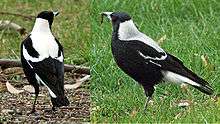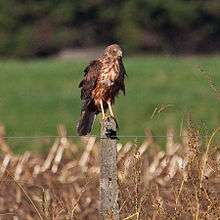Australian magpies in New Zealand

The Australian magpie is a medium-sized black and white passerine bird native to Australia and southern New Guinea. Members of two subpecies groups, black-backed and white-backed magpies, were introduced into New Zealand to control pests in pastures but have themselves become an invasive species. The birds can be aggressive and commonly attack humans and occasionally native birds. Cyclists can also be attacked, especially during nesting season of the bird.[1]
Introduction into New Zealand
Birds taken mainly from Tasmania and Victoria in Australia were introduced into New Zealand by local Acclimatisation Societies of Otago and Canterbury in the 1860s, with the Wellington Acclimatisation Society releasing 260 birds in 1874. White-backed forms are spread on both the North and eastern South Island, while black-backed forms are found in the Hawke's Bay region.[2] Magpies were introduced into New Zealand to control agricultural pests, and were therefore a protected species until 1951.[3] It is currently illegal to breed, sell, or distribute the birds within New Zealand.[4]
Evidence of pest status
Due to the lack of scientific study, evidence of the magpie as a predator of native species is often anecdotal.[5] They are thought to affect bird populations such as the tui and kereru, sometimes raiding nests for eggs and nestlings,[3] although studies by Waikato University have cast doubt on this,[6] The same authors suggest that birds avoid areas close to magpies as they are sometimes attacked by breeding adults, but actual attacks are infrequent.[7]

Regional controls
Pest management is generally done at a regional level in New Zealand and specific Regional Pest Management Strategies (RPMS) are developed. The Biosecurity Act 1993 grants powers to territorial authorities to carry out pest control.
Nine regional councils funded a study by Landcare Research and Waikato University, which concluded magpies did have a small effect upon other birds but found no evidence that they are serious pests – therefore any control measures would be for other reasons (e.g. conflict with humans).[8]
- Nelson
The Nelson City Council classes the magpie (both black-backed and white-backed forms) as a Containment Pest under the Nelson Tasman Regional Pest Management Strategy. This means that the Council will encourage the control of the magpies, including the supply of traps. Under the Biosecurity Act magpies cannot be knowingly sold, propagated, bred, released, or commercially displayed.[9]
- Wellington
In the Wellington Region magpies are classed as a Site-led pest animal.[10] Under the RPMS for the region magpies are controlled for human health and environmental reasons using a variety of methods.[11]
- Southland
The Southland Regional Council also includes magpies in their RPMS.
Cultural references
The comic Footrot Flats features a magpie character by the name of Pew.[12] It is portrayed as dysfunctional after being hand reared and often seeking revenge after the tree in which it had nested was cut down.
The Magpies was a popular poem written in 1964 by poet Denis Glover. In the poem each verse except for the last one ended with the couplet:
- And Quardle oodle ardle wardle doodle/The magpies said,
This imitation of the distinctive call of the magpie is one of the most recognised lines in New Zealand poetry.
See also
References
- ↑ Burdon, Nathan (30 September 2010). "Magpie ends tour hopes for promising Kiwi cyclist". Southland Times. Fairfax NZ News. Retrieved 28 June 2012.
- ↑ Long, John L. (1981). Introduced Birds of the World: The worldwide history, distribution and influence of birds introduced to new environments. Terrey Hills, Sydney: Reed. p. 344. ISBN 0-589-50260-3.
- 1 2 Troup, Christina (20 November 2008). "Introduced land birds: Australian Magpie". Te Ara – the Encyclopedia of New Zealand. Ministry for Culture & Heritage (New Zealand). Retrieved 23 December 2008.
- ↑ "Pest Animals Everyone's Responsibility:Magpies, Gymnorhina species" (PDF). Wellington Regional Council. 15 March 2011. Retrieved 6 November 2012.
- 1 2 Morgan, D.; Waas J. R. & Innes J. (2005). "Magpie interactions with other birds in New Zealand: results from a literature review and public survey". Notornis. Ornithological Society of New Zealand. Retrieved 5 November 2012.
- ↑ Morgan, D; Waas, J; Innes, J (2006). "The relative importance of Australian magpies (Gymnorhina tibicen) as nest predators of rural birds in New Zealand". New Zealand Journal of Zoology. 33: 17–29. doi:10.1080/03014223.2006.9518427.
- ↑ Morgan D; Waas, J; Innes, J (2005). "Do territorial and non-breeding Australian magpies Gymnorhina tibicen influence the local movements of rural birds in New Zealand?". Ibis. 148 (2): 330–42. doi:10.1111/j.1474-919X.2006.00545.x.
- ↑ John Innes; et al. (19 July 2004). "Magpies Are Not Serious Pests" (PDF). Kararehe Kino, June 2004. Archived from the original (PDF) on 6 February 2013. Retrieved 6 November 2012.
- ↑ "Australian magpie". Nelson City Council. 25 May 2012. Retrieved 28 June 2012.
- ↑ "Site led pest animals " Magpies". Greater Wellington Regional Council. 16 March 2011. Retrieved 28 June 2012.
- ↑ Greater Wellington – Regional Pest Management Strategy 2002 – 2022 Five Year Review 2007 (PDF), Greater Wellington, pp. 109–110, retrieved 28 June 2012
- ↑ Troup, Christina (20 November 2008). "Introduced land birds: Footrot Flats cartoon". Introduced land birds. Te Ara: The Encyclopedia of New Zealand. Retrieved 23 December 2008.
Further reading
- Glover, Denis; Frizzel, Dick (December 2000). The Magpies. Random House New Zealand. ISBN 9781869620424.
- Kaplan, Gisela (2004). Australian Magpie: Biology and Behaviour of an Unusual Songbird. Melbourne, Victoria: CSIRO Publishing. ISBN 0-643-09068-1.
External links
| Wikimedia Commons has media related to Gymnorhina tibicen. |
- Australian magpie at Te Ara: The Encyclopedia of New Zealand
- Gymnorhina tibicen at the Invasive Species Specialist Group